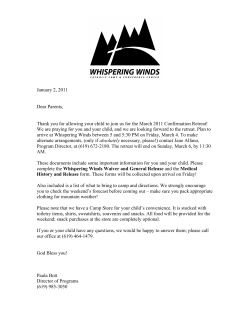
1 Aussie Weather Watchers â CLICK HERE
1 Aussie Weather Watchers – CLICK HERE Introduction My name is Shane Rowe and I would like to quickly introduce myself and this special mini report. I have brought this information together to help aussie weather watchers increase their understanding of the Australian weather map. You will find here all the information you need to get a basic understanding of the Australian weather map. I trust you will find this information useful – please feel free to contact me should you need any further assistance. Kindest Regards, Shane 2 Aussie Weather Watchers – CLICK HERE A weather map is simply a display of air pressure at the surface of the earth, which is measured in millibars and shown on a barometer. The lines on a weather map are called isobars. These isobars connect to other areas that have the same air pressure. The letter "L" represents an area of Low air pressure, while the letter "H" represents an area of high air pressure. Areas of low pressure are usually associated with strong winds, rain and thunderstorms. While areas of high pressure are usually associated with light winds and clear skies. Frosts and fogs over the southern inland regions during the winter months are also associated with high pressure systems. The dotted blue line on a weather map is a low pressure trough, this is an area of unstable air usually to the north of high pressure systems that often produce thunderstorms. The blue lines with triangles are cold fronts which are usually located to the south of high pressure systems and are linked to low pressure systems in the southern ocean. A cold front is basically where a cold airmass meets a warmer airmass which often produce gusty winds, showers, thunderstorms and a drop in temperature as it moves through. 3 Aussie Weather Watchers – CLICK HERE In the summer months, the high pressure systems move further south providing more settled conditions in the south. At the same time this allows very moist unstable northwest winds associated with the monsoon to move over the tropical parts of Australia which provides heavy rain and thunderstorms to northern areas, this also includes tropical cyclones which are very intense low pressure systems that form over warm oceans. Below is what a typical summer weather map looks like. It shows two high pressure systems over the oceans to the south of the country with hot northerly winds blowing down into South Australia ahead of a low pressure trough which is the blue dotted line. Tropical Cyclone Dot is sitting off the Queensland coast with heavy rain and gales out to sea. 4 Aussie Weather Watchers – CLICK HERE In the winter months the high pressure systems move further north which then results in more settled dry weather across northern Australia. Southern Australia then is under the influence of westerly winds with embedded cold fronts that link to intense low pressure systems in the southern ocean which provide regular bursts of cold, wet and windy weather and snow to the mountains. Below is what a typical winter weather map looks like. It shows two high pressure systems bringing dry settled conditions to the inland and northern Australia. While a cold front with strong winds and showers is moving through Victoria and Tasmania and another cold front is approaching Western Australia. 5 Aussie Weather Watchers – CLICK HERE In the southern hemisphere which includes the Australian region, the air moves clockwise around low pressure systems and anti-clockwise around high pressure systems. This provides a good indication of the direction that the wind would be coming from for any location on the map. In general,if the wind direction is coming off the ocean the air mass would be more moist, however if the wind direction is blowing from the land, the air mass would be drier. The closer the isobars are on a weather map, the stronger the winds would be. In general the lines or isobars around areas of low pressure are closer together which indicates strong winds, while the isobars around areas of high pressure are spaced further apart indicating light winds. In summary, by looking at a weather map, it gives a good indication of what number the air pressure would be in millibars in your location, which would be displayed on your barometer. Also at a glance you can understand the type of air mass that is affecting a location by the wind direction and the strength of the wind. Combine that with the time of year that it is and the amount of cloud that is around which is shown on a satellite photo, it provides a general understanding of what the temperatures would be. 6 Aussie Weather Watchers – CLICK HERE 7 Aussie Weather Watchers – CLICK HERE
© Copyright 2025









